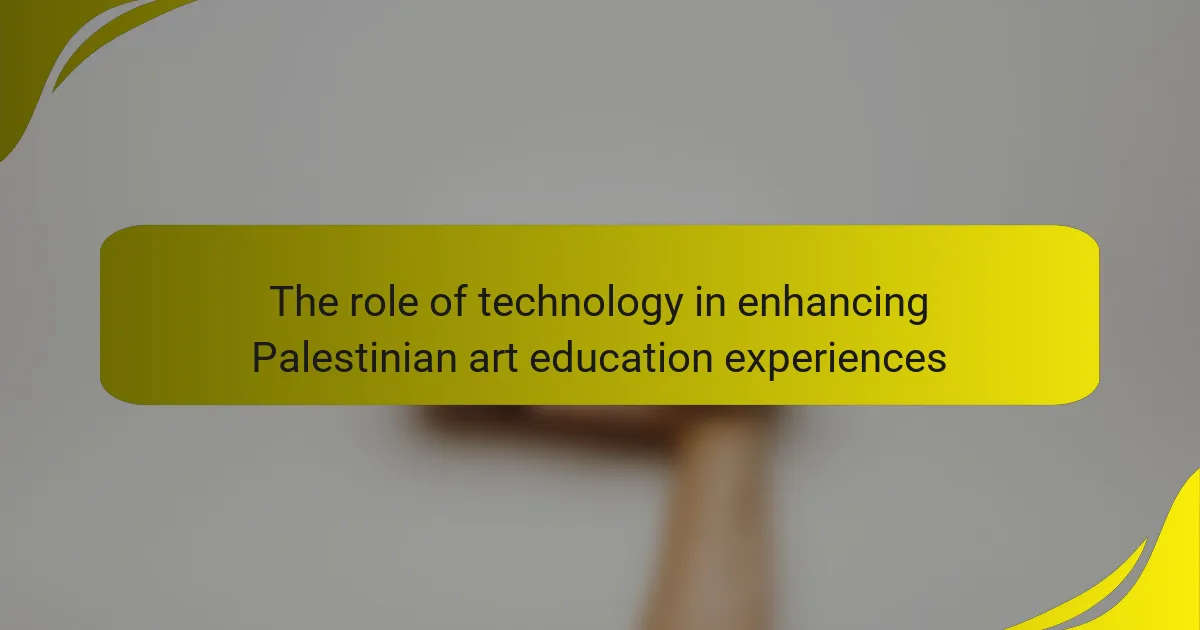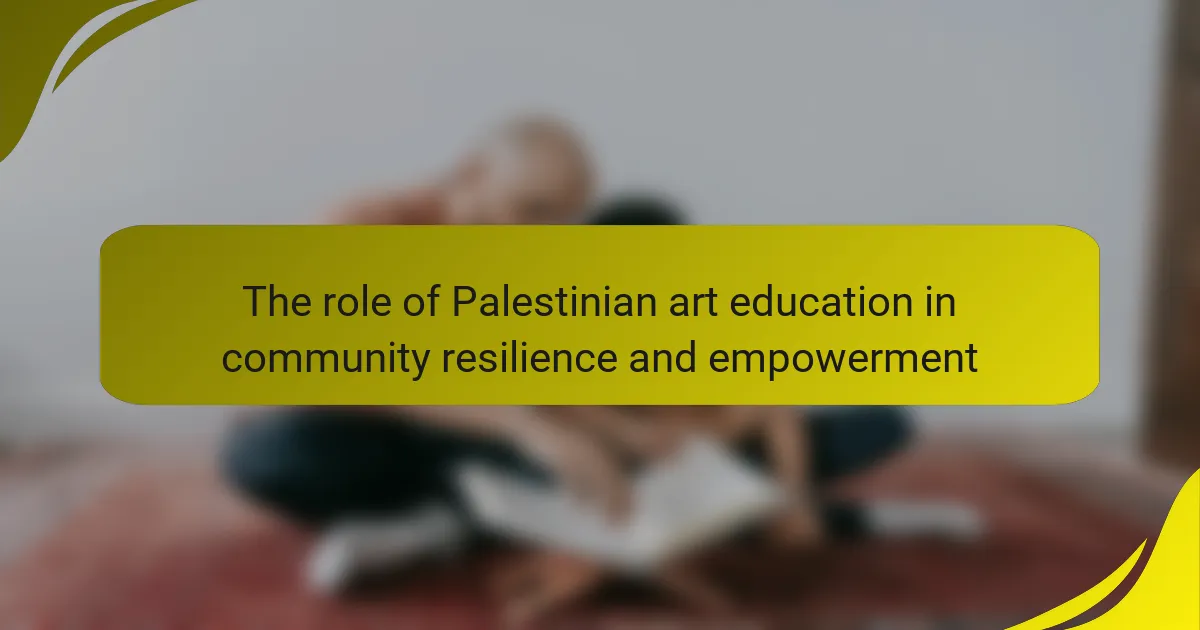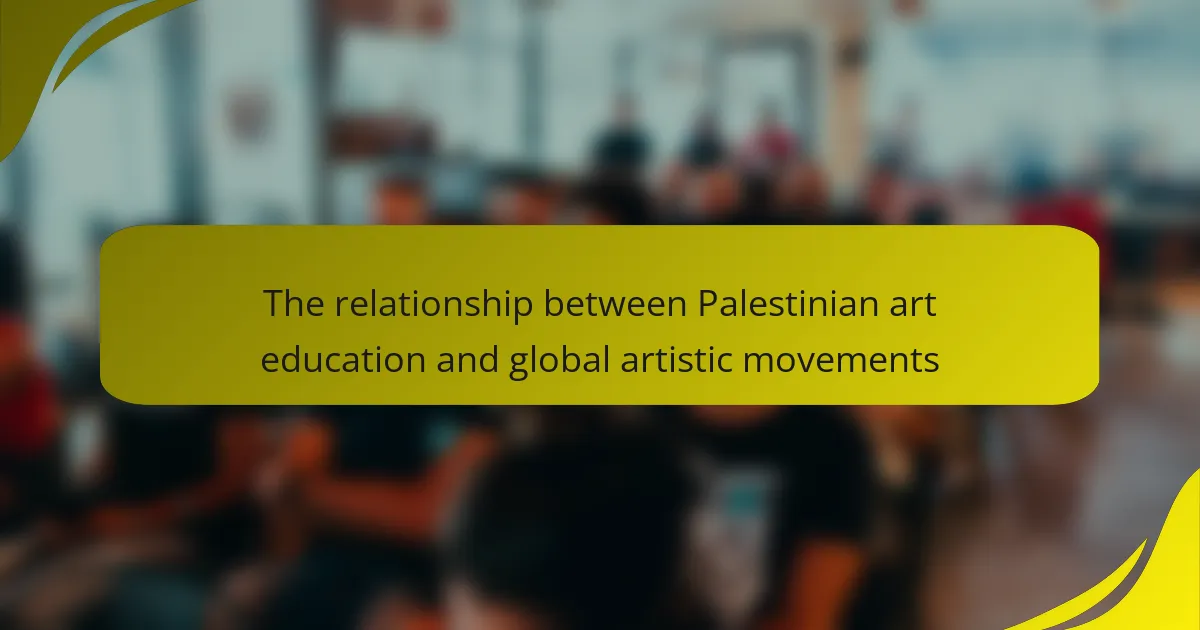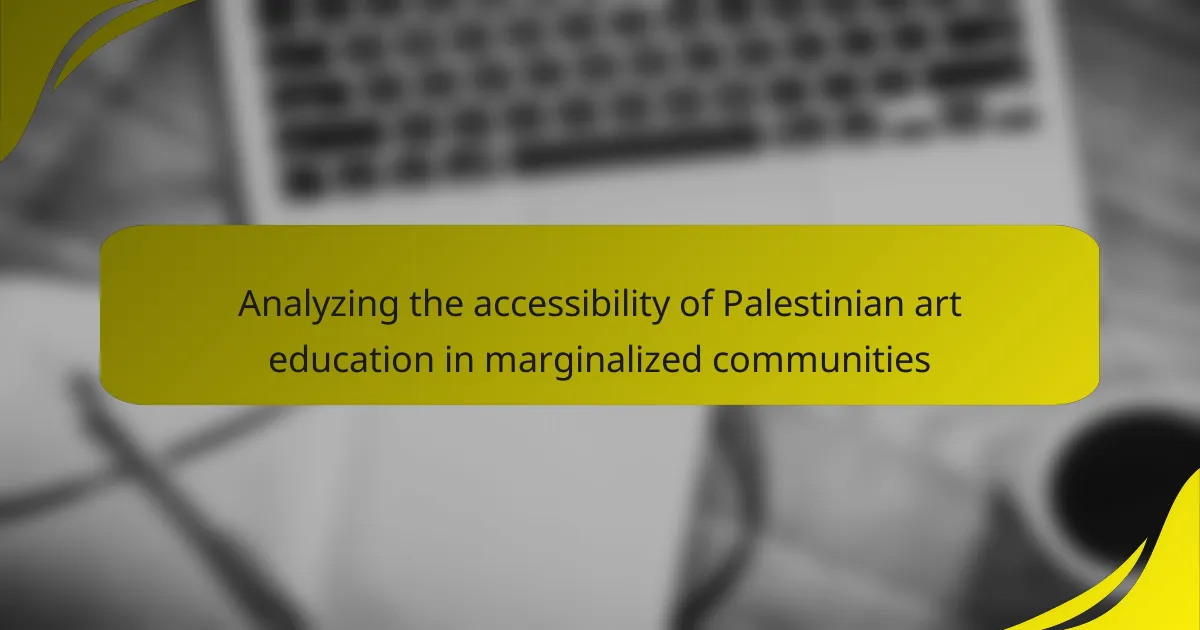Palestinian art education is essential for fostering cultural identity and enabling individuals to articulate their heritage through various artistic mediums. It enhances creativity and critical thinking, which are vital for cultural preservation and political expression. Through this educational framework, students gain insights into their history, traditions, and socio-political realities, reinforcing community bonds and collective memory. Additionally, art education facilitates dialogue and understanding among diverse groups, allowing Palestinians to assert their identity on both local and global platforms.
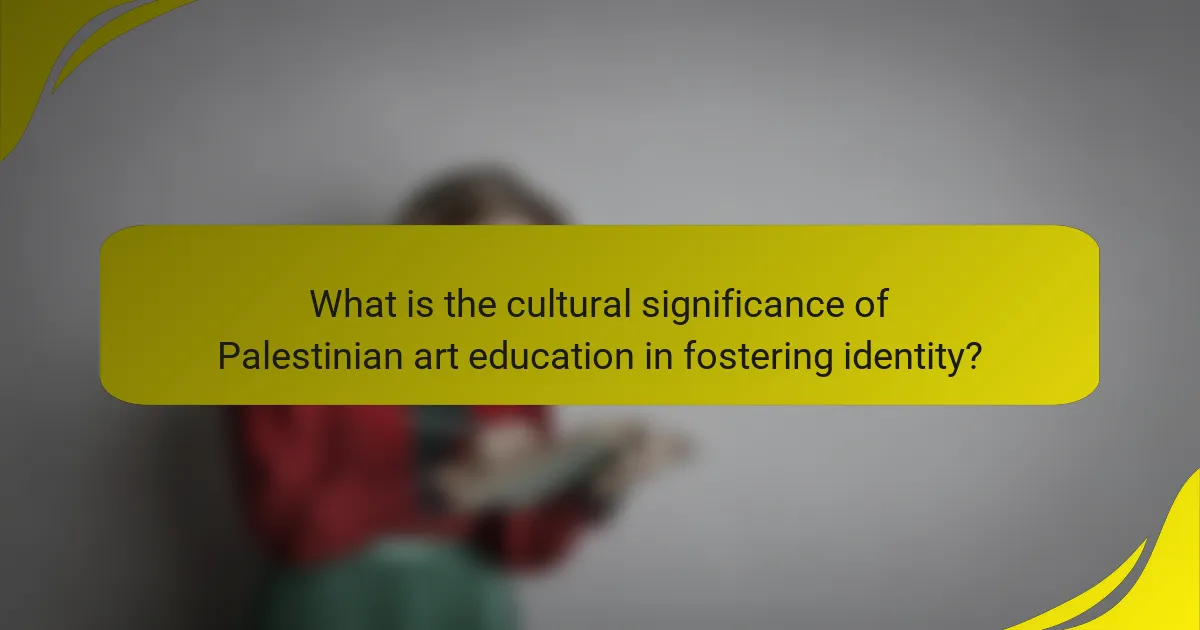
What is the cultural significance of Palestinian art education in fostering identity?
Palestinian art education plays a crucial role in fostering cultural identity. It enables individuals to express their heritage and personal narratives through various artistic forms. Art education encourages creativity and critical thinking, which are essential for cultural preservation. It also serves as a medium for political expression and resistance against oppression. Through art, students learn about their history, traditions, and the socio-political context of their existence. This engagement helps to strengthen community bonds and collective memory. Moreover, art education promotes dialogue and understanding among diverse groups. By participating in art, Palestinians can assert their identity on both local and global stages.
How does Palestinian art education contribute to cultural identity?
Palestinian art education significantly contributes to cultural identity by fostering a sense of belonging and continuity. It engages students with their historical narratives and cultural symbols. Through art, students express their experiences and perspectives related to their identity. This education often incorporates traditional themes, reinforcing the connection to Palestinian heritage. Workshops and community projects promote collaboration and collective memory. Art education also serves as a platform for political expression, reflecting the struggles and aspirations of the Palestinian people. Research shows that students involved in art education demonstrate a stronger awareness of their cultural identity. This engagement helps preserve Palestinian traditions and promotes resilience among youth.
What are the historical roots of art education in Palestine?
Art education in Palestine has historical roots dating back to the Ottoman Empire. During this period, traditional crafts and artistic practices were integral to cultural expression. The establishment of formal art institutions began in the early 20th century. This was influenced by the wider Arab Renaissance and the desire for national identity. The British Mandate further shaped art education by introducing Western educational models. Post-1948, art education became a means of cultural preservation. Palestinian artists sought to express their identity through various forms of art. Today, art education continues to play a crucial role in cultural and national identity.
How does art education reflect Palestinian heritage and traditions?
Art education reflects Palestinian heritage and traditions through the incorporation of cultural themes and historical narratives. It emphasizes traditional crafts, such as embroidery and pottery, which are integral to Palestinian identity. Students learn about the symbolism in Palestinian art, including motifs that represent land and resistance. The curriculum often includes the study of renowned Palestinian artists who convey cultural stories through their work. Art education also serves as a medium for expressing social and political issues relevant to Palestinian society. By engaging with these elements, students develop a deeper understanding of their cultural roots. This educational approach fosters a sense of pride and continuity in Palestinian heritage.
Why is art education important in the Palestinian context?
Art education is important in the Palestinian context because it fosters cultural identity and resilience. It allows individuals to express their experiences and emotions through creative outlets. Art education serves as a means of preserving Palestinian heritage and traditions. This is crucial in a region facing ongoing conflict and political challenges. Studies show that art can enhance critical thinking and problem-solving skills. Engaging in art helps communities to unite and communicate their narratives. Moreover, art education can empower youth by providing them with tools for self-expression and advocacy. Thus, in the Palestinian context, art education plays a vital role in cultural preservation and community cohesion.
What role does art play in community cohesion among Palestinians?
Art plays a crucial role in community cohesion among Palestinians. It serves as a medium for expressing shared experiences and cultural identity. Through art, individuals communicate their narratives and struggles. This fosters a sense of belonging and unity within the community. Art initiatives often bring people together for collaborative projects. Events such as exhibitions and workshops create spaces for dialogue. They encourage collective participation and strengthen social bonds. Historical events, like the establishment of cultural centers, have highlighted art’s unifying power. Overall, art is integral in reinforcing community ties among Palestinians.
How does art education empower Palestinian youth?
Art education empowers Palestinian youth by providing them with a means of self-expression. It fosters creativity and critical thinking skills essential for personal development. Through art, youth can explore their cultural identity and heritage. This exploration helps them articulate their experiences and perspectives. Art education also promotes emotional resilience and social cohesion among peers. Programs often encourage collaboration, building community ties. Moreover, engaging in art can raise awareness of social and political issues affecting their lives. Studies show that art initiatives have led to increased confidence and motivation among participants. Overall, art education serves as a vital tool for empowerment and identity formation among Palestinian youth.
What challenges does Palestinian art education face?
Palestinian art education faces significant challenges due to political instability and limited resources. The ongoing conflict restricts access to educational facilities and materials. Many art programs lack funding, impacting their ability to provide quality instruction. Additionally, there is a shortage of trained art educators in the region. This limits the exposure students have to diverse artistic techniques and perspectives. Furthermore, the cultural context often influences the themes and subjects that can be explored in art. Restrictions on freedom of expression can stifle creativity among students. These factors collectively hinder the development of a robust art education system in Palestine.
How do political factors impact art education in Palestine?
Political factors significantly impact art education in Palestine. The ongoing conflict restricts resources and access to educational facilities. Many schools face funding shortages due to political instability. Restrictions on movement hinder students and teachers from participating in art programs. Curriculum content is often influenced by political ideologies. This affects the representation of Palestinian culture in art education. Furthermore, the lack of international support limits opportunities for artistic development. These factors collectively shape the landscape of art education in Palestine, influencing both access and content.
What resources are lacking for effective art education in Palestinian communities?
Palestinian communities lack essential resources for effective art education. These include adequate funding for art programs and materials. Many schools do not have access to basic art supplies like paint, brushes, and canvas. Additionally, there is a shortage of trained art educators who can provide quality instruction. Limited exposure to diverse art forms restricts students’ creative development. Access to cultural institutions, such as galleries and museums, is also minimal. Furthermore, community support for art initiatives is often lacking. These deficiencies hinder the growth of artistic expression and identity among Palestinian youth.
How can art education be enhanced to better foster identity?
Art education can be enhanced to better foster identity by incorporating culturally relevant content. This approach allows students to connect their personal experiences with their heritage. Integrating local artists and traditions into the curriculum can strengthen this connection. Providing opportunities for community engagement through art projects fosters a sense of belonging. Encouraging self-expression in various art forms allows students to explore their identities. Research shows that culturally responsive teaching improves student engagement and achievement. This method has been effective in various educational contexts, demonstrating its impact on identity formation.
What innovative approaches can be implemented in Palestinian art education?
Innovative approaches in Palestinian art education include integrating technology and community engagement. Utilizing digital platforms can enhance accessibility to art resources. Virtual art galleries can showcase local artists and their work globally. Collaborative projects with international artists can foster cross-cultural exchanges. Incorporating traditional Palestinian art forms into curricula can strengthen cultural identity. Workshops that focus on contemporary issues can encourage critical thinking. Art therapy programs can support mental health among students. These approaches can empower students and promote resilience in the face of challenges.
How can collaboration with international art communities benefit Palestinian art education?
Collaboration with international art communities can significantly enhance Palestinian art education. This partnership can provide access to diverse artistic techniques and methodologies. Exposure to global art practices fosters creativity and innovation among Palestinian artists. International collaboration can also facilitate the exchange of ideas and cultural narratives. This exchange helps to enrich the local art scene and promotes cultural understanding. Additionally, international partnerships can lead to funding opportunities for art programs. Increased resources can improve educational infrastructure and access to materials. Overall, such collaborations strengthen the artistic voice of Palestinian communities on a global platform.
What are best practices for promoting Palestinian art education?
Best practices for promoting Palestinian art education include integrating local culture into curricula. This approach fosters a sense of identity among students. Collaboration with local artists can enhance the educational experience. Workshops and community events can showcase student work and engage the public. Utilizing digital platforms can expand reach and accessibility. Establishing partnerships with international art organizations can provide resources and exposure. Funding and grants should be pursued to support art programs. Engaging in advocacy for art education can help raise awareness of its importance. These strategies collectively strengthen the cultural significance of Palestinian art education.
How can local organizations support art education initiatives?
Local organizations can support art education initiatives by providing funding and resources. They can sponsor workshops, art supplies, and educational programs. Collaborating with local artists enhances the quality of instruction. Organizations can also create partnerships with schools to integrate art into the curriculum. Hosting community art events raises awareness and engagement. Research indicates that community involvement in art education fosters cultural identity. For instance, studies show that art programs improve student achievement and self-expression.
What strategies can artists and educators use to engage students effectively?
Artists and educators can engage students effectively by incorporating interactive and collaborative activities. These activities encourage participation and foster a sense of community. For instance, group projects allow students to work together, sharing ideas and perspectives. This collaborative approach enhances creativity and critical thinking. Additionally, integrating local cultural themes into lessons makes content more relatable. This relevance can increase students’ interest and investment in learning. Utilizing technology, such as digital art tools, also appeals to modern learners. These tools can facilitate innovative expression and engagement. Research shows that active participation in art education improves retention and understanding of cultural identity.
Palestinian art education is a vital entity that fosters cultural identity and community cohesion among Palestinians. This article examines the significant role of art education in expressing heritage, preserving traditions, and promoting resilience amidst ongoing political challenges. It explores the historical roots of art education in Palestine, the incorporation of cultural themes, and the impact of political factors on access and resources. Additionally, it discusses innovative approaches and best practices to enhance art education, empowering youth and strengthening collective identity within Palestinian communities.
